tow MITSUBISHI ECLIPSE 1990 Owner's Manual
[x] Cancel search | Manufacturer: MITSUBISHI, Model Year: 1990, Model line: ECLIPSE, Model: MITSUBISHI ECLIPSE 1990Pages: 391, PDF Size: 15.27 MB
Page 299 of 391
![MITSUBISHI ECLIPSE 1990 Owners Manual ir yAUTOMATIC TRANSAXLE
- Trahsaxle Control21-774th Gear
3rd GearRear clutchKickdown
1servo
release sideFront clutch
-
Rear clutch3rd1-2 shiftKickdown
Front clutch
q]b Ture,‘r z&eside
7
1750107
1F MITSUBISHI ECLIPSE 1990 Owners Manual ir yAUTOMATIC TRANSAXLE
- Trahsaxle Control21-774th Gear
3rd GearRear clutchKickdown
1servo
release sideFront clutch
-
Rear clutch3rd1-2 shiftKickdown
Front clutch
q]b Ture,‘r z&eside
7
1750107
1F](/img/19/57103/w960_57103-298.png)
ir yAUTOMATIC TRANSAXLE
- Trahsaxle Control21-774th Gear
3rd GearRear clutchKickdown
1servo
release sideFront clutch
-
Rear clutch3rd1-2 shiftKickdown
Front clutch
q]b Ture,‘r z&eside
7
1750107
1Fromk-D3rd 14th pressure
control valve1 ;l;hiftpressure1750108
Upshift from
3rd to 4th Gear
.When the 4th pressure (line pressure) from the shift
control valve is directed to the rear clutch exhaust
valve through the No.8 line. the valve is pushed to
the right, closing the No.5c port. This cuts off the
pressure to the rear clutch and also releases the
pressure acting on the rear clutch through NO.
15port, No.20a port and No. 20
port.On the other hand, the rear clutch exhaust
valvewhich is pushed to the right opens the NO. 19
POnand directs the 4th pressure (line pressure) to the
right end of the
2-3/4-3 shift valve. The 3rdpressure (or the No.7 line pressure) is acting on theleft
end of the 2-3/4-3 shift valve. As this Pressure
..is equal to the No. 19 line pressure and acts on the
Mme area, the spring at the right end of the valveWhen the 4th pressure is released by the move-
ment of the shift control valve, the rear clutchDownshift from 4th to
3rd Gear
exhaust valve moves to the left, creating a
3rd gearstate, and the pressure is directed to the rear clutch.
At the same time as this happens, the 4th pressure
in No. 19 line which has been acting on the 2-3/4-3shift valve is released. This causes the
3rd pressure
established in the
No.7 line to push the 2-3/4-3shift valve to the right, and creates a 3rd gear state
where the line pressure from the
l-2 shift valve is
directed to the front clutch and the release side
chamber of kickdown servo cylinder through the
No. 12 line.shes the valve toward the
left. closing the No. 11me pressure port. This
btocks the pressure to the
front clutch and the release side chamber ofkickdown servo cylinder, and the pressure is re-
leased through the No. 12. and then the
No.9~ Pofi.
Page 300 of 391
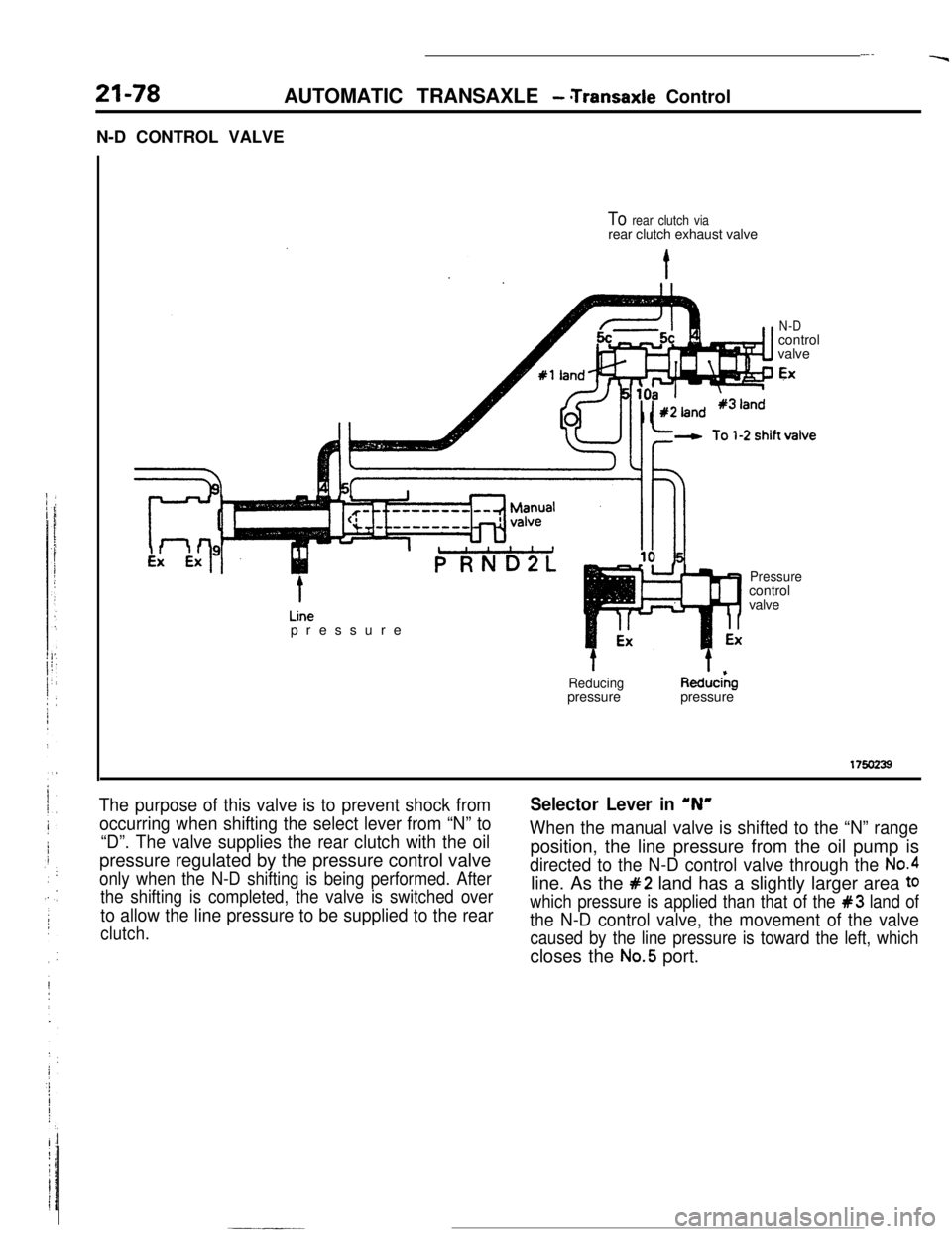
21-78AUTOMATIC TRANSAXLE - Transaxle Control
N-D CONTROL VALVE
.-.‘r
To rear clutch viarear clutch exhaust valve
N-Dcontrol
valve
EXpressure
Pressurecontrol
valve
t
Reducingpressure
t
Red”&pressure
175oz39
The purpose of this valve is to prevent shock from
occurring when shifting the select lever from “N” to
“D”. The valve supplies the rear clutch with the oilpressure regulated by the pressure control valve
only when the N-D shifting is being performed. After
the shifting is completed, the valve is switched over
to allow the line pressure to be supplied to the rear
clutch.
Selector Lever in ‘N”
When the manual valve is shifted to the “N” rangeposition, the line pressure from the oil pump is
directed to the N-D control valve through the No.4line. As the
#2 land has a slightly larger area to
which pressure is applied than that of the #3 land of
the N-D control valve, the movement of the valve
caused by the line pressure is toward the left, whichcloses the
No.5 port.
Page 301 of 391
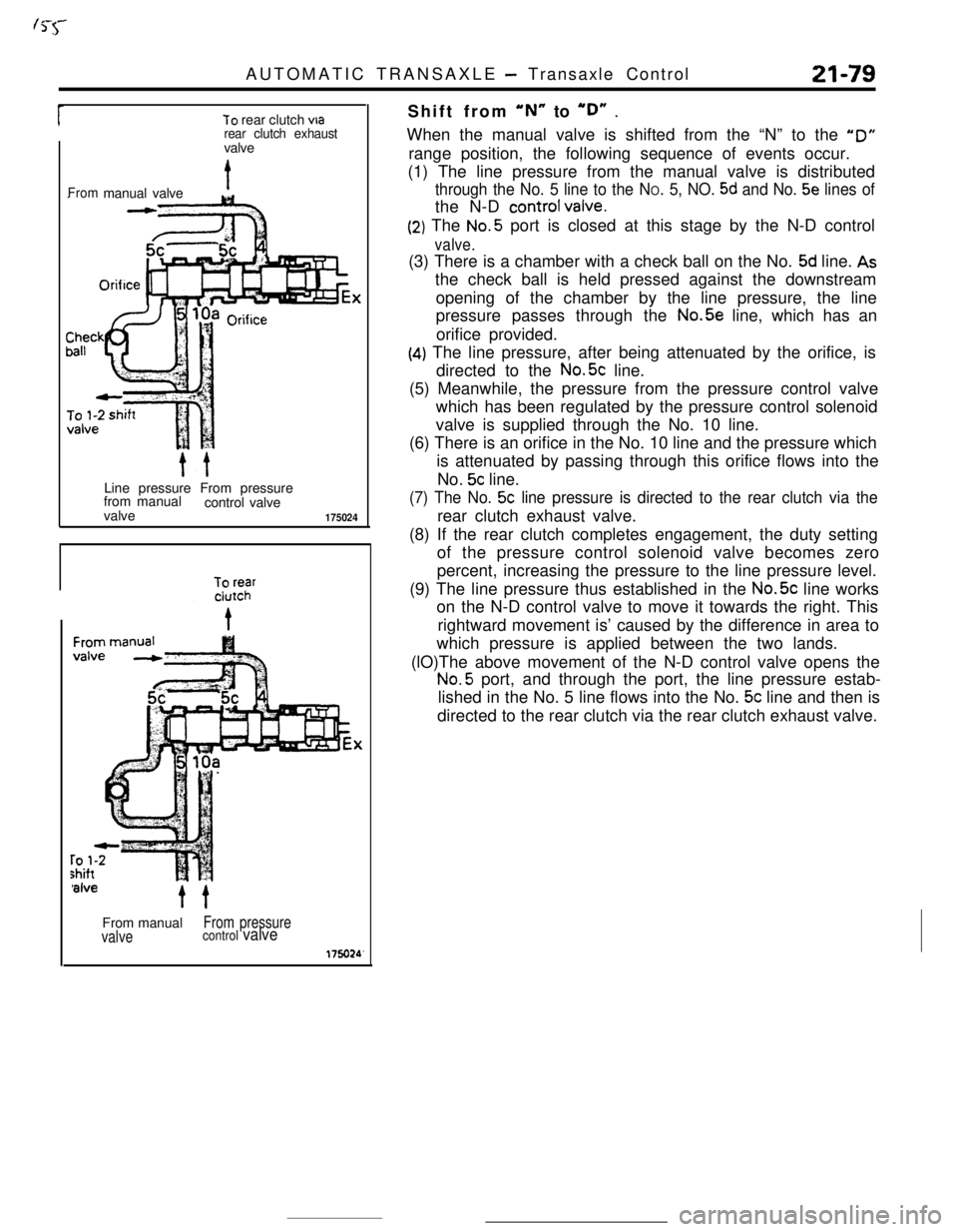
AUTOMATIC TRANSAXLE - Transaxle Control21-79
70 rear clutch via
rear clutch exhaustvalve
Frommanual valveOrifice
Line pressure From pressure
from manual
control valve
valve
175024
valveFrom manual
From pressure
valvecontrol valve175024Shift from “N” to
“D” .
When the manual valve is shifted from the “N” to the
“D”range position, the following sequence of events occur.
(1) The line pressure from the manual valve is distributed
through the No. 5 line to the NO. 5, NO. 5d and No. 5e lines ofthe N-D control
VdVe.
(2) The No.5 port is closed at this stage by the N-D control
valve.(3) There is a chamber with a check ball on the No.
5d line. Asthe check ball is held pressed against the downstream
opening of the chamber by the line pressure, the line
pressure passes through the
No.Se line, which has an
orifice provided.
(4 The line pressure, after being attenuated by the orifice, is
directed to the No.5c line.
(5) Meanwhile, the pressure from the pressure control valve
which has been regulated by the pressure control solenoid
valve is supplied through the No. 10 line.
(6) There is an orifice in the No. 10 line and the pressure which
is attenuated by passing through this orifice flows into the
No.
5c line.
(7) The No. 5c line pressure is directed to the rear clutch via therear clutch exhaust valve.
(8) If the rear clutch completes engagement, the duty setting
of the pressure control solenoid valve becomes zero
percent, increasing the pressure to the line pressure level.
(9) The line pressure thus established in the No.5c line works
on the N-D control valve to move it towards the right. This
rightward movement is’ caused by the difference in area to
which pressure is applied between the two lands.
(lO)The above movement of the N-D control valve opens theNo.5 port, and through the port, the line pressure estab-
lished in the No. 5 line flows into the No.
5c line and then is
directed to the rear clutch via the rear clutch exhaust valve.
Page 303 of 391
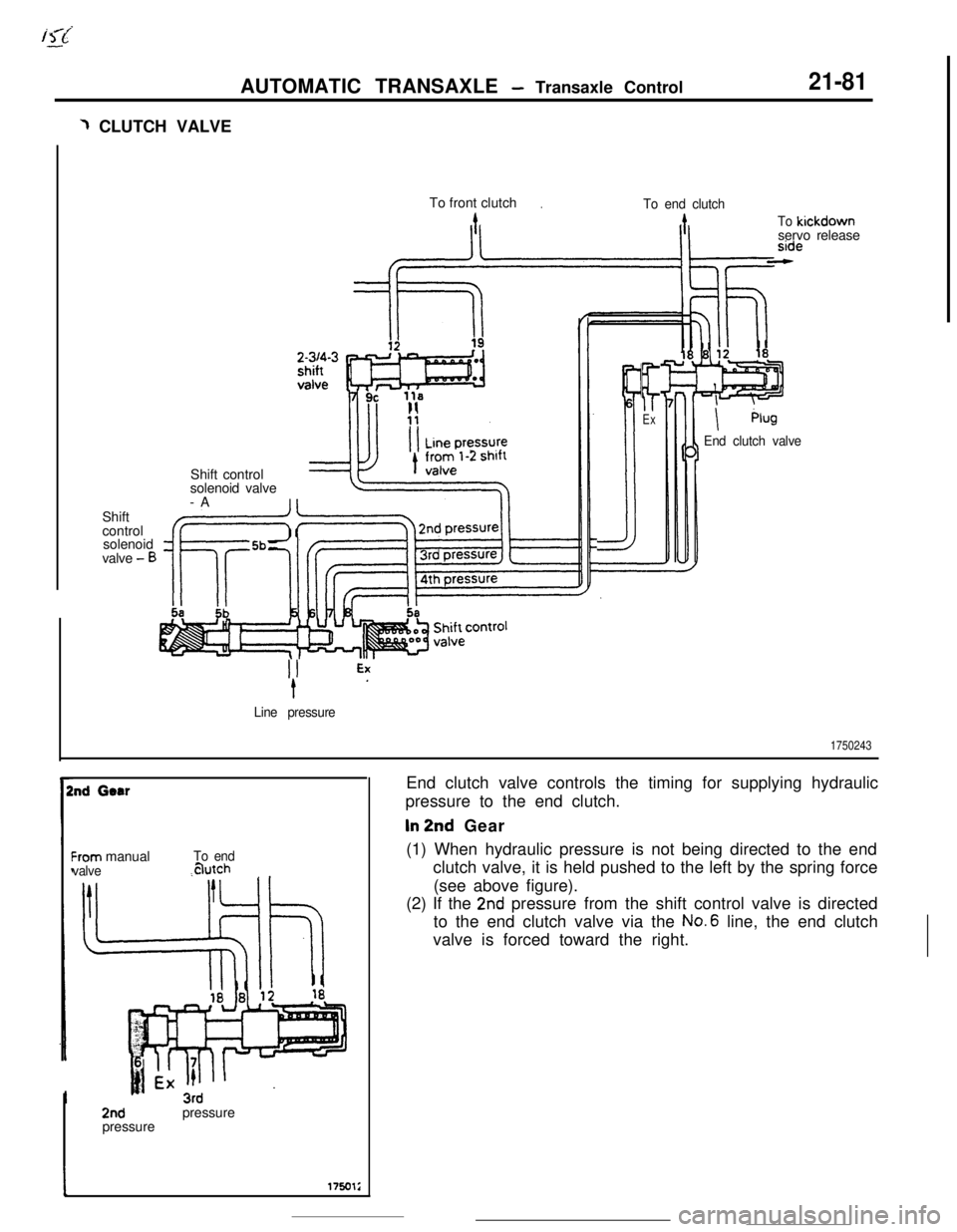
AUTOMATIC TRANSAXLE - Transaxle Control21-81
3 CLUTCH VALVE
To front clutch
.To end clutch
To kickdown
servo release
Shift
control
solenoid
valve
- BShift control
solenoid valve
-A
II
J
ExIPlug
End clutch valve
‘11 E”
Line pressure
1750243End clutch valve controls the timing for supplying hydraulic
pressure to the end clutch.In 2nd Gear
(1) When hydraulic pressure is not being directed to the end
clutch valve, it is held pushed to the left by the spring force
(see above figure).
(2) If the
2nd pressure from the shift control valve is directed
to the end clutch valve via the No.6 line, the end clutch
valve is forced toward the right.
,nd Gear
Lrom manualvalveTo end,&tch.
2ndpressurepressure
I17501i
Page 304 of 391

21-82AUTOMATIC TRANSAXLE - Transaxle Control
valve
A
2nd3rdpressure pressure175011:To shift
control
valve#3
land
2nd3rdpressure pressure
175011~LlUpshift from
2nd to 3rd Gear\(1) When the shift control valve comes into
3rd gear position
and the
3rd pressure is established, the pressure is
directed to the No.7 port of the end clutch valve through
the No.7 line. In this instance, the
3rd pressure is blocked
ahead by the end clutch valve and the check ball.
(2) If a shift to the
3rd gear is initiated, the pressrue begins to
be directed from the
2-3/4-3 shift valve to the front clutch
and the release side chamber of kickdown servo cylinder.
The same pressure also is directed to the chamber at the
right end of the end clutch valve through the No. 12 line.
During the shift to the
3rd gear, the pressure in the No. 12
line is regulated by the pressure control valve to a level
lower than the line pressure so that the No. 12 line pressureis not high enough to force the end clutch valve toward the
left.(3) Once the front clutch has been engaged and the kickdown
brake released, the No. 12 line pressure is raised to a level .
equivalent to the line pressure.
This means that the pressures at both ends of the end
j
clutch valve (or No. 6 line pressure and No. 12 line pressure)[are at the same level. However, as the area of the
#3 land
to which pressure is applied is larger than that of the
# 1
land of the end clutch valve, the valve is pushed to left, thusopening the No.
18 port. This allows the 3rd pressure (line
pressure) already established in the No. 7 line to be directedto the end clutch through
the..No.7 port. The end clutch is
now engaged.
Downshift from
3rd to 2nd Gear
(1) Both front clutch pressure and kickdown servo release
pressure are released, and therefore, the pressure in
theend clutch valve right end chamber is also released.
--
(2) This results in a rightward movement of the end clutclvalve by the
2nd pressure working on its left end, closingthe
No.7 port and releasing the end clutch pressurethrough the No.8 port. Now the end clutch is released,
I
Page 307 of 391
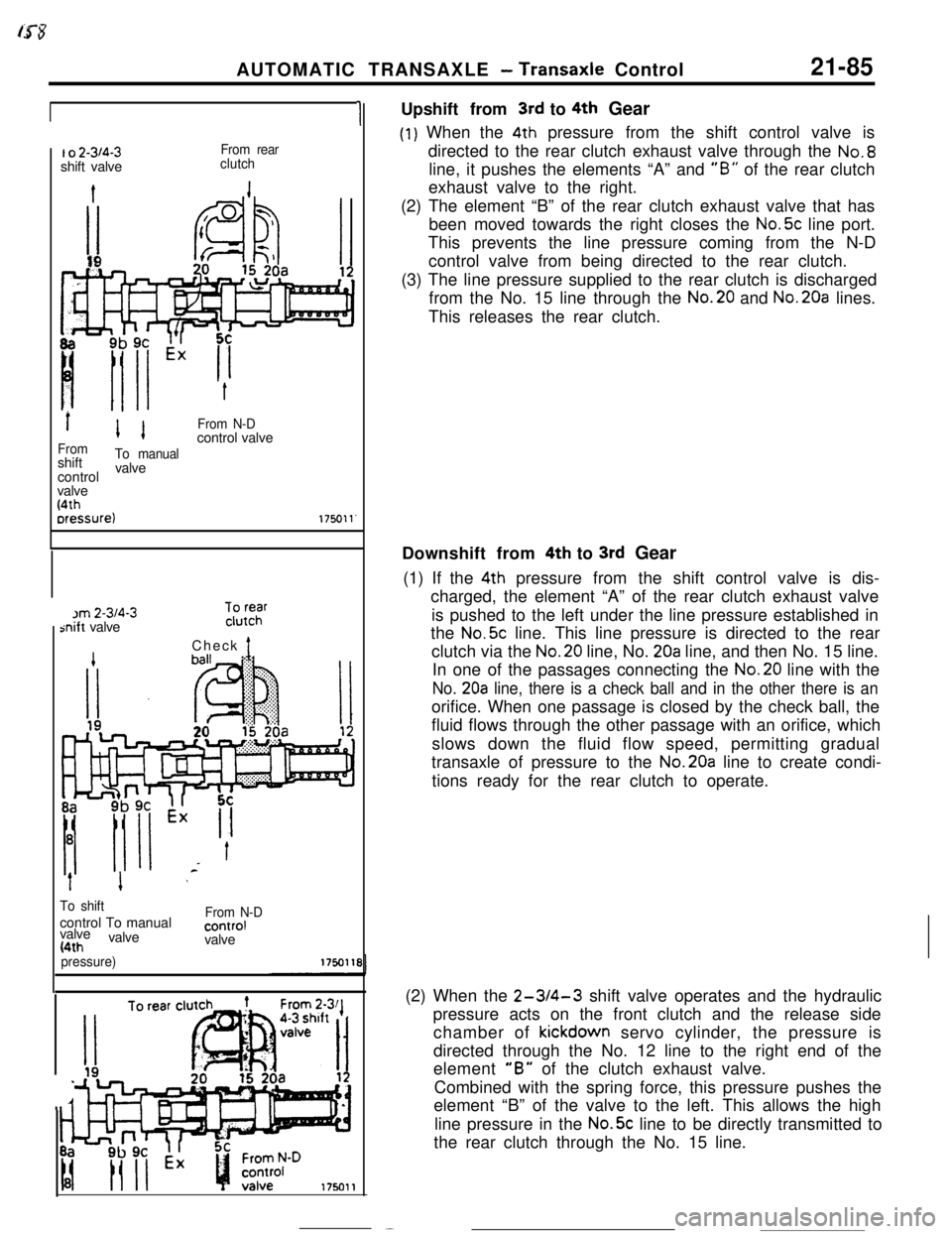
AUTOMATIC TRANSAXLE - Transaxle Control21-85
I o 2-314-3shift valveFrom rear
clutch
11 1From N-Dcontrol valve
FromshiftTo manualcontrolvalve
valve
(4thoressure)175011‘
1
>rn 2-314-3jnift valveTCPUE’Check t
I
To shiftcontrol To manualFrom N-Dmntmlvalve
”.,,l”l
(4thvalve
valvepressure)
--
II1111
”
E,Upshift from
3rd to 4th Gear
(1) When the 4th pressure from the shift control valve is
directed to the rear clutch exhaust valve through the No.8
line, it pushes the elements “A” and
“B” of the rear clutch
exhaust valve to the right.
(2) The element “B” of the rear clutch exhaust valve that has
been moved towards the right closes the
No.5~ line port.
This prevents the line pressure coming from the N-D
control valve from being directed to the rear clutch.
(3) The line pressure supplied to the rear clutch is discharged
from the No. 15 line through the No.20 and No.20a lines.
This releases the rear clutch.
Downshift from 4th to
3rd Gear
(1) If the
4th pressure from the shift control valve is dis-
charged, the element “A” of the rear clutch exhaust valve
is pushed to the left under the line pressure established in
the
No.5~ line. This line pressure is directed to the rear
clutch via the No.20 line, No.
20a line, and then No. 15 line.
In one of the passages connecting the No.20 line with the
No. 20a line, there is a check ball and in the other there is anorifice. When one passage is closed by the check ball, the
fluid flows through the other passage with an orifice, which
slows down the fluid flow speed, permitting gradual
transaxle of pressure to the No.20a line to create condi-
tions ready for the rear clutch to operate.
(2) When the
2-3/4-3 shift valve operates and the hydraulic
pressure acts on the front clutch and the release side
chamber of kickdown servo cylinder, the pressure is
directed through the No. 12 line to the right end of the
element
“8” of the clutch exhaust valve.
Combined with the spring force, this pressure pushes the
element “B” of the valve to the left. This allows the high
line pressure in the
No.5~ line to be directly transmitted to
the rear clutch through the No. 15 line.
Page 313 of 391
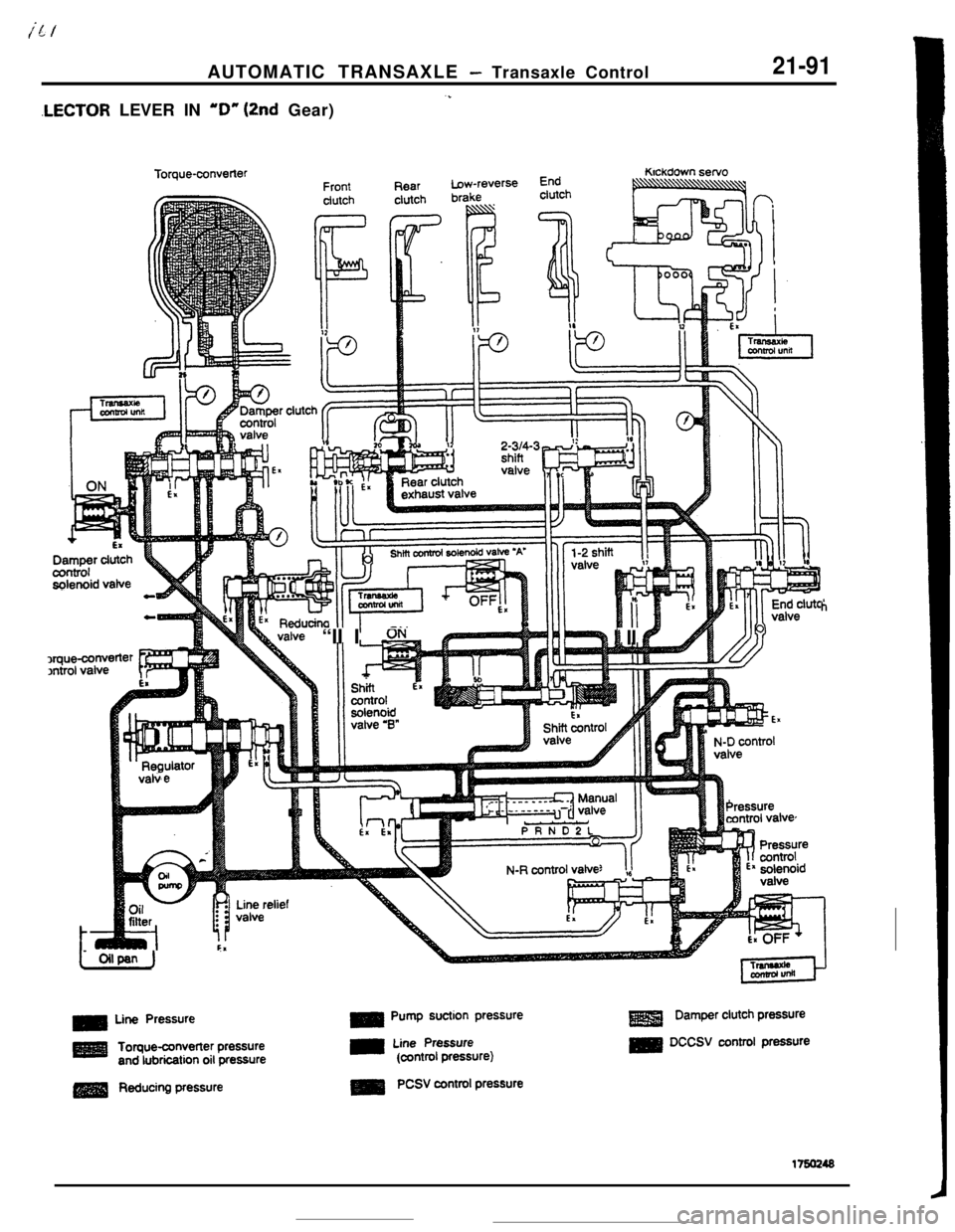
AUTOMATIC TRANSAXLE - Transaxle Control21-91
.LECTOR LEVER IN ‘D” (2nd Gear)Torque-converter
FrontdutchKEkctown servoRearLow-reverseEnd
clutchbrakeclutch
ri
t
valr
hvalve
“II I
ON-II II
LOUpan)-
N-D controlvalve
Pressurecontrol valve
N-R control valve
118 Line Pressure
Torqueconverter pressureand lubrication oil pressure
m Pump suction pressure
m Line Pressure(control pressure)Damper clutch pressurem DCCSV control pressureReducing pressure
PCSV control pressure
Page 339 of 391
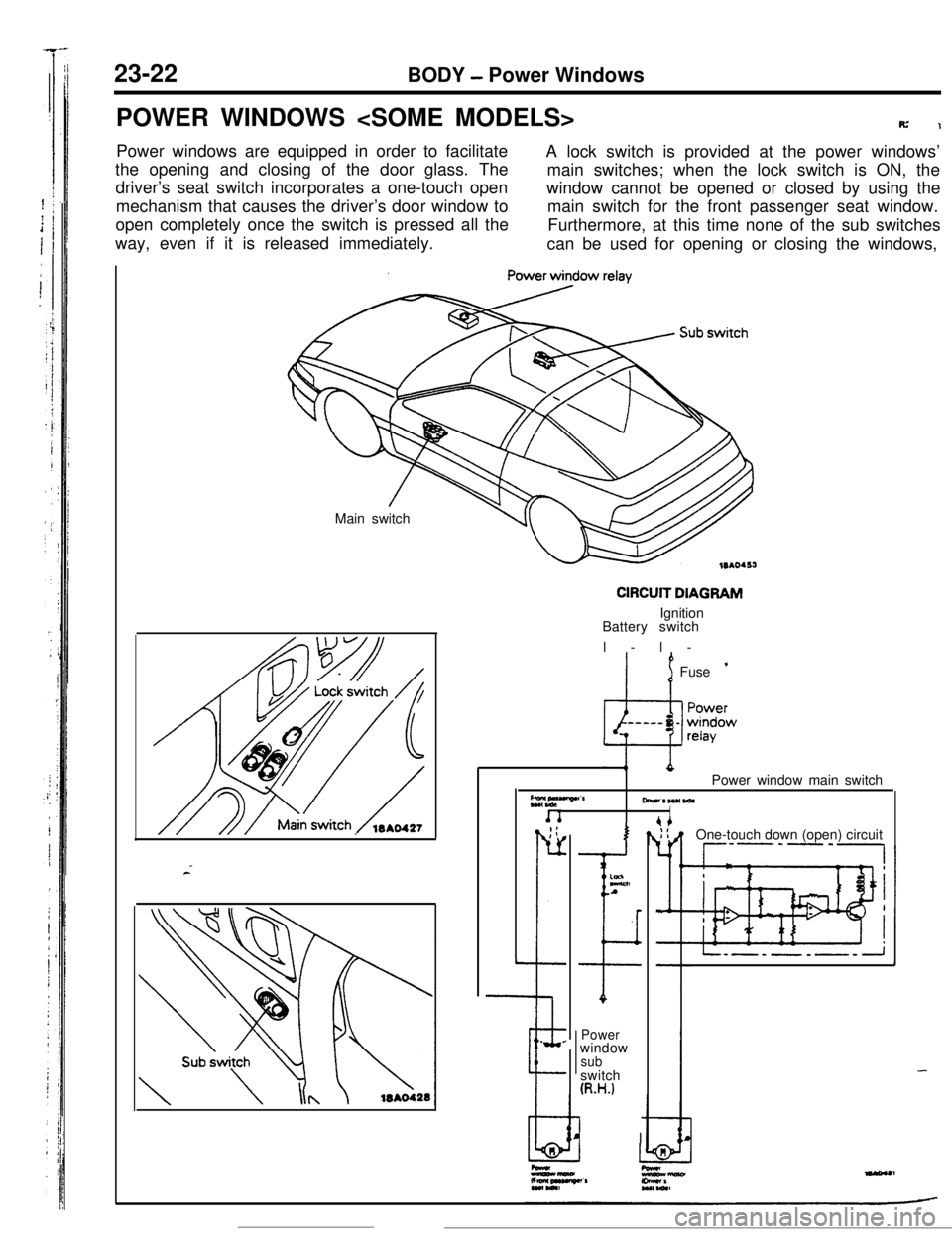
23-22BODY - Power Windows
POWER WINDOWS
R’1Power windows are equipped in order to facilitate
A lock switch is provided at the power windows’
the opening and closing of the door glass. The
main switches; when the lock switch is ON, the
driver’s seat switch incorporates a one-touch open
mechanism that causes the driver’s door window towindow cannot be opened or closed by using the
main switch for the front passenger seat window.
open completely once the switch is pressed all the
way, even if it is released immediately.Furthermore, at this time none of the sub switches
can be used for opening or closing the windows,
Main switch
CIRCUIT DIAGRAMIgnition
Battery switch
l-l-
’ 1Fuse ’
Z*,“““”CrPower window main switch
-*W(WlI. _;:
r-
L
--e.
.
I
ELnA
I
Powerwindow
subswitch
(R.H.)
I IOne-touch down (open) circuit
--P’-‘-,
-
Page 342 of 391
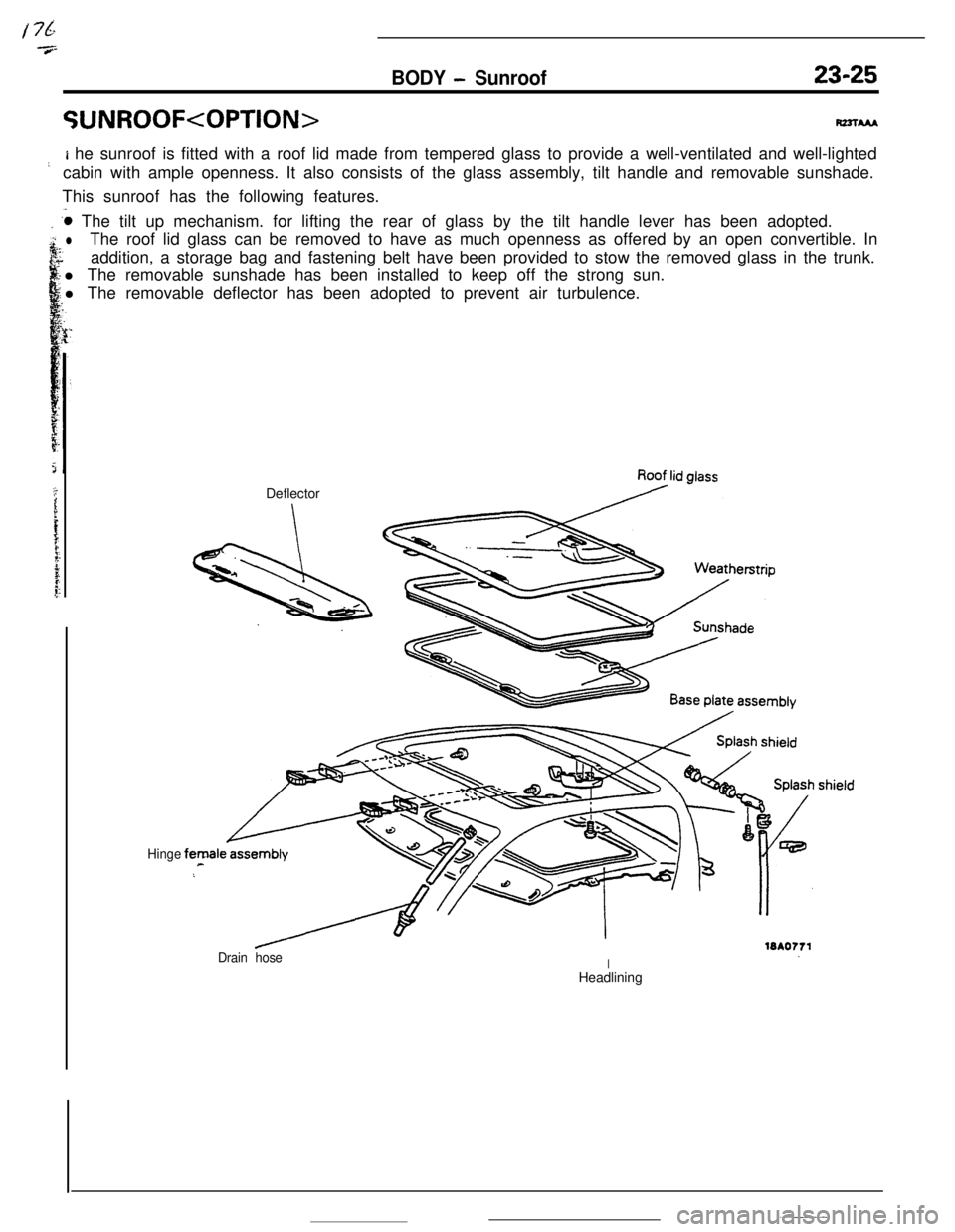
CUNROOF
Page 345 of 391
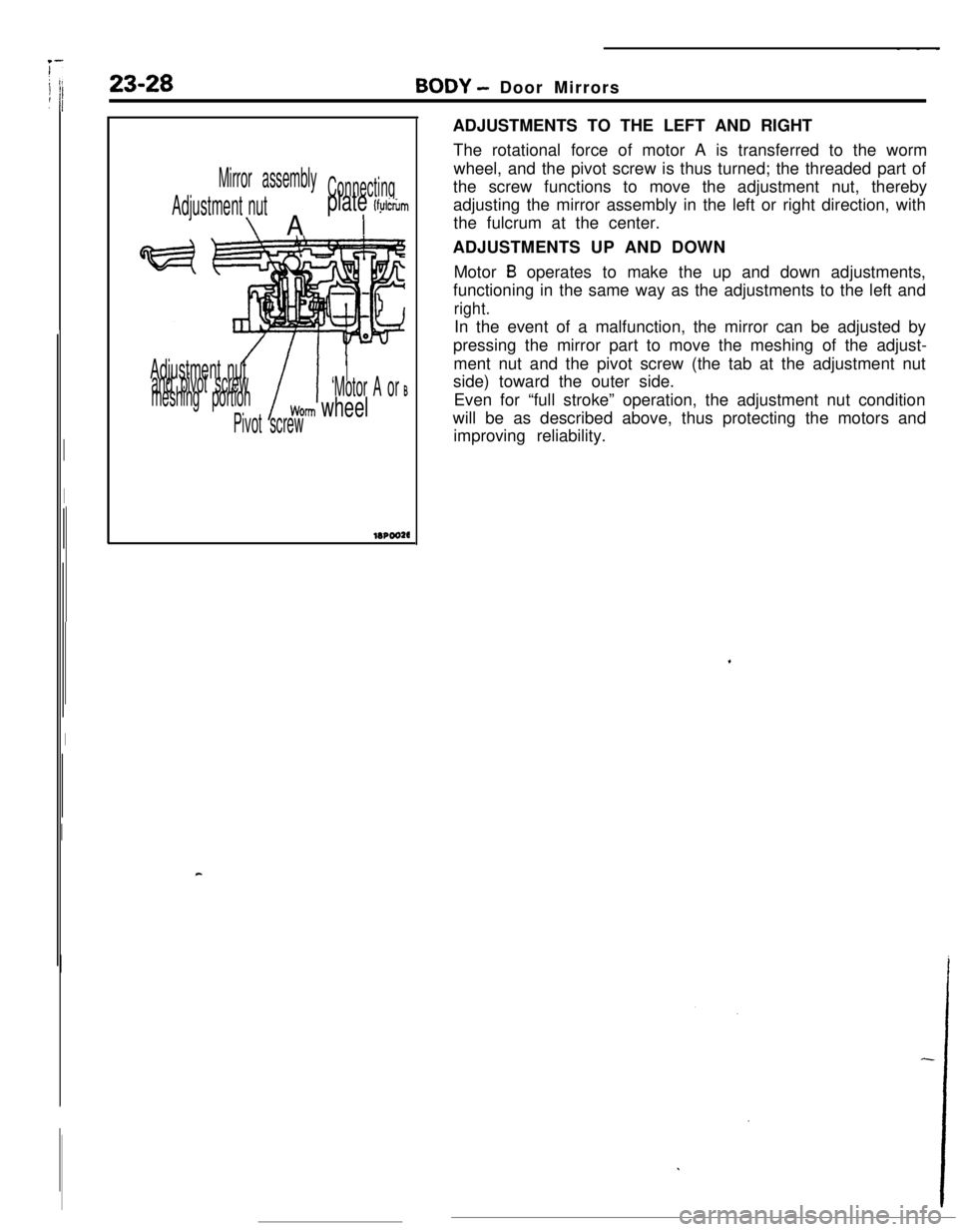
Mirror assemblywheel, and the pivot screw is thus turned; the threaded part of
Adjustment nut
\A
Connectingthe screw functions to move the adjustment nut, therebyplate (fylcrum
Iadjusting the mirror assembly in the left or right direction, with
the fulcrum at the center.
23-28---BODY - Door Mirrors
ADJUSTMENTS TO THE LEFT AND RIGHT
The rotational force of motor A is transferred to the worm
Adjustment nutand pivot screwI
meshing portionI ’‘Motor A or
B
Worm wheel
Pivot screwADJUSTMENTS UP AND DOWN
Motor
B operates to make the up and down adjustments,
functioning in the same way as the adjustments to the left and
right.In the event of a malfunction, the mirror can be adjusted by
pressing the mirror part to move the meshing of the adjust-
ment nut and the pivot screw (the tab at the adjustment nut
side) toward the outer side.
Even for “full stroke” operation, the adjustment nut condition
will be as described above, thus protecting the motors and
improving reliability.
c